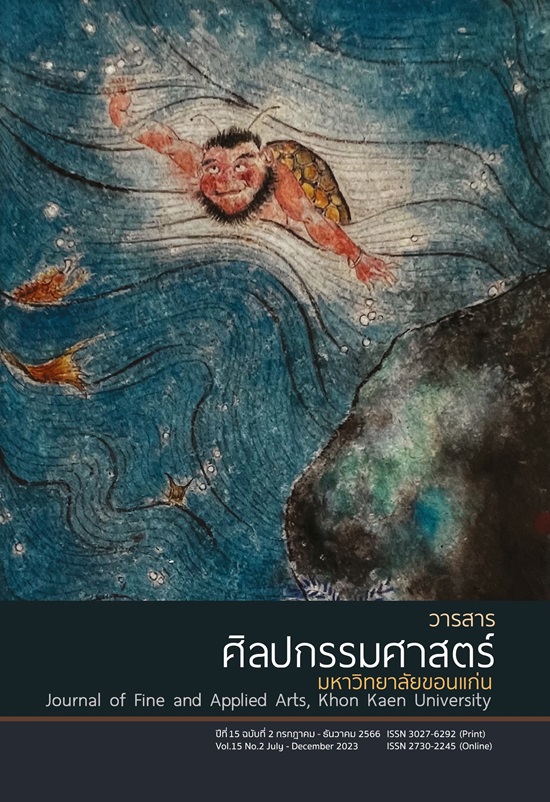Development of Label for Coconut Juice, Klin Ai Tan Community Enterprise, Bang Thorat Sub-District, Mueang Samut Sakhon District, Samut Sakhon Province.
Main Article Content
Abstract
The objectives of this research work are 1) to study on information and direction for the development of label of coconut juice product of Klin Ai Tan Community Enterprise, Bang Thorat Sub-district, Mueang Samut Sakhon District, Samut Sakhon Province; 2) to develop label of coconut juice product; and 3) to assess the satisfaction toward the prototype label of coconut juice product. This research work uses mixed methodology that is the combination between qualitative and qualitative research methodologies. The area in which the research work is conducted is Bang Thorat Sub-district, Mueang Samut Sakhon District, Samut Sakhon Province. The key informants consist of 3 community enterprise members, 5 design experts and 100 samples who are consumers, making the total number of key informants become 108. The tools used on this research include the semi-structured interview script, the questionnaire of the evaluation of label of coconut juice product and the questionnaire of the assessment of satisfaction. The samples are selected with purposive sampling and random sampling techniques. The statistical values used include percentages, means and standard deviation. The findings from the research show as follows. 1) Klin Ai Tan Community Enterprise has been producing 100 percent coconut juice from the pollen of coconut flowers. The group has developed and added value to local raw material by transforming it. However, Klin Ai Tan Community Enterprise still lacks of knowledge and comprehension in marketing principles; additionally, there are still few channels for distribution and promotion of the product. Consequently, the product is not well known among consumers. Also, the current label of the product has no focal point to communicate to consumers. Thus. It cannot attract consumers. The direction for developing the label for coconut juice is to design the label to look outstanding with the key factor of creative economy approach and the key factor of graphic design. 2) In this project, 5 new labels of coconut juice product are designed. The design with the greatest mean is Design 2 which is appropriate in the high level (𝑥̅ = 3.69, S.D. = 0.98). Afterward, a prototype label in Design 2 is produced. 3) The findings from the assessment of samples’ satisfaction towards the designed label show that the samples are highly satisfied with the overall design of the label of coconut juice product (𝑥̅ = 4.08, S.D. = 0.95). Meanwhile, the factor with the highest mean is the factor of creative economy approach, which has achieved the high level of satisfaction (𝑥̅ = 4.13, S.D. = 0.92). As for the other factor, or the factor of the communication of the label, the satisfaction in high level (𝑥̅ = 4.03, S.D. = 0.97). The item in the factor of creative economy approach that consumers are most satisfied with is the item of the capability of the label of adding value to a new product that is made from local raw material, with the satisfaction in the high level (𝑥̅ = 4.19, S.D. = 0.87). As for the factor of the communication of the label, the consumers are most satisfied with the item of the capability of the image that clearly depicts the product and is beautiful, with all signs and symbols in proper sizes shown, the satisfaction to which is in the high level (𝑥̅ = 4.13, S.D. = 0.91).
Article Details

This work is licensed under a Creative Commons Attribution-NonCommercial-NoDerivatives 4.0 International License.
Content and information in articles published in the Journal of Fine and Applied Arts of Khon Kaen University is regarded as the opinion and sole responsibility of the author(s) directly; therefore, editors are not obliged to agree to or share any responsibility with regard to the content and information that appears within these articles.
All articles, information, content, image, etc. that have been published in the Journal of Fine and Applied Arts of Khon Kaen University is the copyright of the Journal of Fine and Appllied Arts of Khon Kaen University. Any person or organization who wishes to distribute all or parts of the articles for further dissemination or other usage must first receive permission from the Journal of Fine and Applied Arts of Khon Kaen University before proceeding to do so.
References
จิรวุฒิ หลอมประโคน. (2561). อิทธิพลของปัจจัยด้านการออกแบบป้ายฉลากบรรจุภัณฑ์ต่อพฤติกรรมการซื้อของผู้บริโภค: การศึกษาคลื่นไฟฟ้าสมองสัมพันธ์กับเหตุการณ์. วิทยานิพนธ์ปริญญาดุษฎีบัณฑิต สาขาการวิจัยและสถิติทางวิทยาการปัญญา วิทยาลัยวิทยาการวิจัยและวิทยาการปัญญา มหาวิทยาลัยบูรพา.
เจนยุทธ ศรีหิรัญ. (2560). การออกแบบบรรจุภัณฑ์กล้วยแผ่นทอดกรอบสำหรับกลุ่มวิสาหกิจชุมชนเพื่อการส่งออกสู่สาธารณรัฐประชาชนจีน. วารสารวิชาการ ศิลปะสถาปัตยกรรมศาสตร์ มหาวิทยาลัยนเรศวร, 8(2), 132-142.
ชัยมิตร แสวงมงคล. (2561). หลักคิดและการออกแบบกราฟิก. กรุงเทพฯ : คณะวิทยาศาสตร์และเทคโนโลยีมหาวิทยาลัยเทคโนโลยีราชมงคลกรุงเทพ.
ชาตรี บัวคลี่. (2561). การออกแบบและพัฒนาฉลากสินค้าด้วยกระบวนการสื่อสารอย่างมีส่วนร่วม ตามแนวคิดเศรษฐกิจสร้างสรรค์อย่างยั่งยืน. วารสารวิจิตร์ศิลป์, 9(2), 93-144.
ธานินทร์ ศิลป์จารุ. (2563). การวิจัยและวิเคราะห์ข้อมูลทางสถิติด้วย SPSS และ AMOS. พิมพ์ครั้งที่ 18. กรุงเทพฯ : สามัญบิสซิเนสอาร์แอนด์ดี.
ศศิพร ต่ายคำ, และนรินทร์ สังข์รักษา. (2558). การพัฒนารูปแบบผลิตภัณฑ์สร้างสรรค์เพื่อเพิ่มมูลค่าของวิสาหกิจชุมชนจังหวัดราชบุรี. วารสารวิชาการ Veridian E-Journal มหาวิทยาลัยศิลปากร สาขามนุษยศาสตร์ สังคมศาสตร์ และศิลปะ, 8(1), 606-632.
สำนักงานส่งเสริมเศรษฐกิจสร้างสรรค์. (2562). อุตสาหกรรมการออกแบบกับการเป็นกลไกขับเคลื่อนเศรษฐกิจของประเทศ. จับกระแสอนาคตเศรษฐกิจสร้างสรรค์, 1(2), 14-18.
อนัน วาโซะ. (2558). Graphic design for printing & publishing. นนทบุรี : ไอดีซีพรีเมียร์.
Kotler, P., & Keller, K.L. (2009). Marketing management. 13th ed. New Jersey : Pearson Prentice-Hall.


